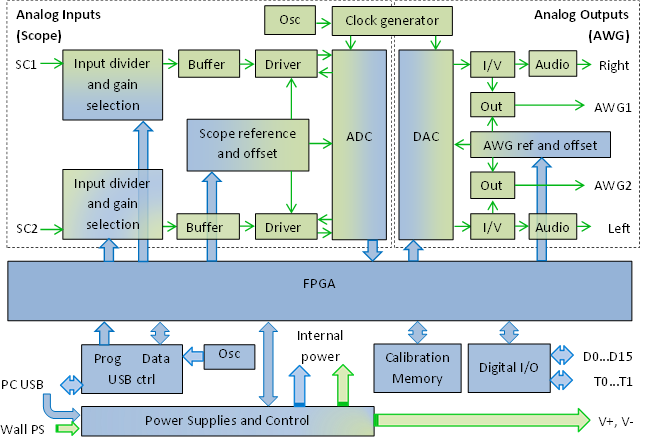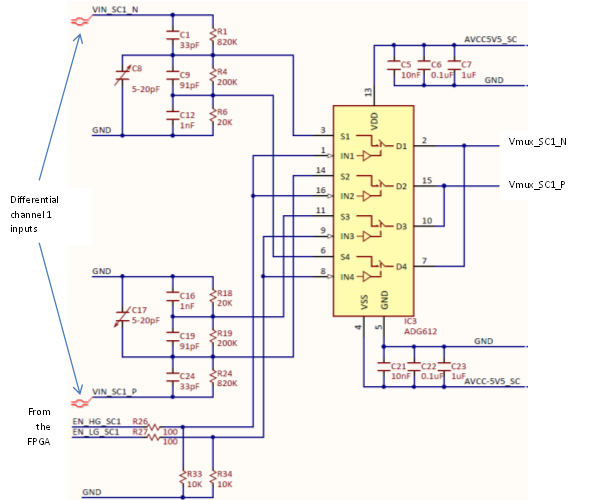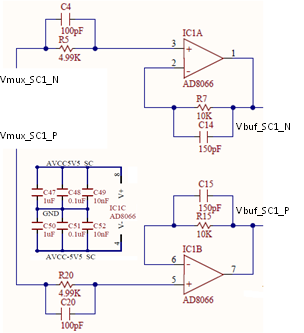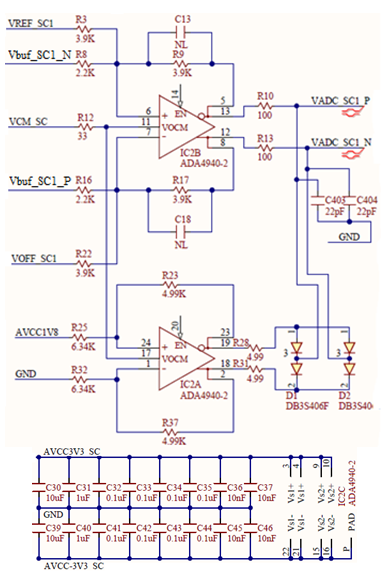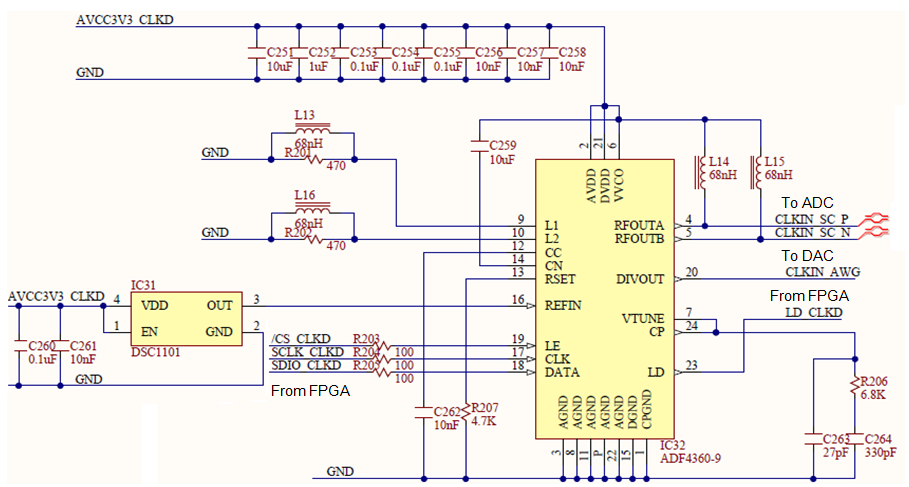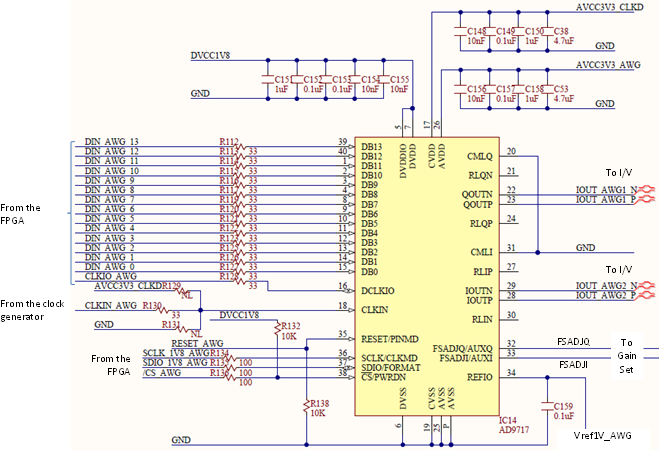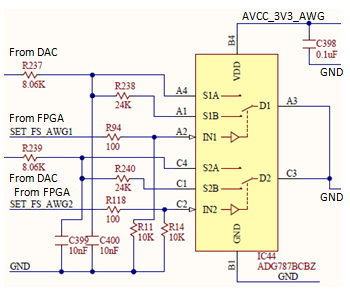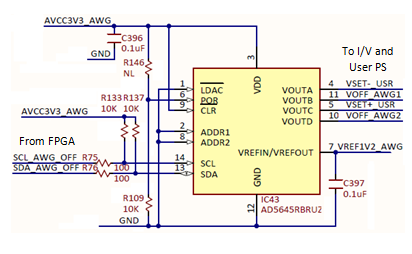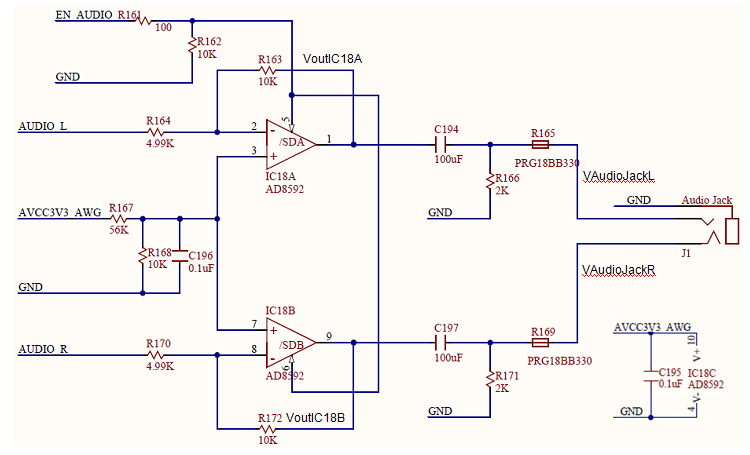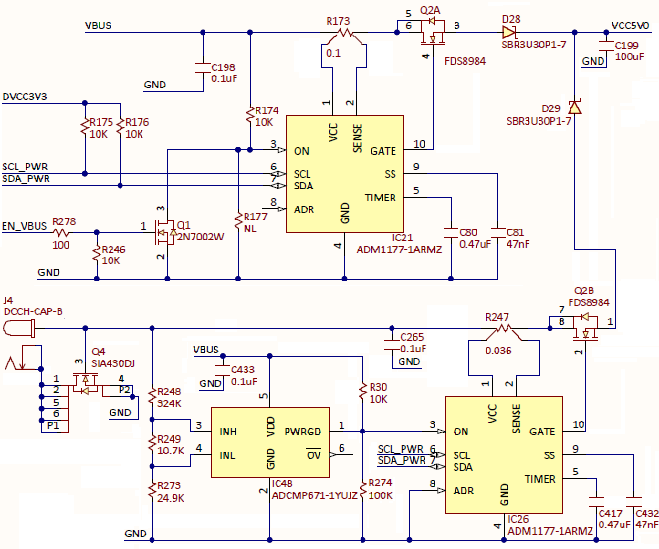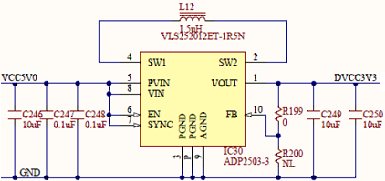目录
Analog Discovery 2 参考手册
1. 概述
The Digilent Analog Discovery 2™, developed in conjunction with Analog Devices®, is a multi-function instrument that allows users to measure, visualize, generate, record, and control mixed signal circuits of all kinds. The low-cost Analog Discovery 2 is small enough to fit in your pocket, but powerful enough to replace a stack of lab equipment, providing engineering students, hobbyists, and electronics enthusiasts the freedom to work with analog and digital circuits in virtually any environment, in or out of the lab. The analog and digital inputs and outputs can be connected to a circuit using simple wire probes; alternatively, the Analog Discovery BNC Adapter and BNC probes can be used to connect and utilize the inputs and outputs. Driven by the free WaveForms software, the Analog Discovery 2 can be configured to work as any one of several traditional instruments, which include:
- Two-channel oscilloscope (1MΩ, ±25V, differential, 14-bit, 100Msample/sec, 30MHz+ bandwidth - with the Analog Discovery BNC Adapter Board)
- Two-channel arbitrary function generator (±5V, 14-bit, 100Msample/sec, 12MHz+ bandwidth - with the Analog Discovery BNC Adapter Board)
- Stereo audio amplifier to drive external headphones or speakers with replicated AWG signals
- Two input/output digital trigger signals for linking multiple instruments (3.3V CMOS)7)
- Two programmable power supplies (0…+5V , 0…-5V). The maximum available output current and power depend on the Analog Discovery 2 powering choice:
- 250mW max for each supply or 500mW total when powered through USB
- 700mA max or 2.1W max for each supply when using an external wall power supply
- Single channel voltmeter (AC, DC, ±25V)
- Network analyzer – Bode, Nyquist, Nichols transfer diagrams of a circuit. Range: 1Hz to 10MHz
- Spectrum Analyzer – power spectrum and spectral measurements (noise floor, SFDR, SNR, THD, etc.)
- Digital Bus Analyzers (SPI, I²C, UART, Parallel)
The Analog Discovery 2 was designed for students in typical university-based circuits and electronics classes. Its features and specifications, as well as the additional requirements of operating from USB or external power, maintaining the small and portable form factor, the robustness to withstand student use in a variety of environments, and low-cost are based directly on feedback that was obtained from numerous professors from several universities. Meeting all of these requirements proved challenging; however, the task ultimately generated some new and innovative circuits. This document describes the Analog Discovery 2's circuits, with the intent of providing a better understanding of its electrical functions, operations, and a more detailed description of the hardware’s features and limitations. It is not intended to provide enough information to enable complete duplication of the Analog Discovery 2, or to allow users to design custom configurations for programmable parts in the design.
连线图

1.1 架构及结构框图
Analog Discovery 2's high-level block diagram is presented in Fig. 2 below. The core of the Analog Discovery 2 is the Xilinx® Spartan®-6 FPGA (specifically, the XC6SLX16-1L device). The WaveForms application automatically programs the Discovery’s FPGA at start-up with a configuration file designed to implement a multi-function test and measurement instrument. Once programmed, the FPGA inside the Discovery communicates with the PC-based WaveForms application via a USB 2.0 connection. The WaveForms software works with the FPGA to control all the functional blocks of the Analog Discovery 2, including setting parameters, acquiring data, and transferring and storing data.
Signals in the Analog Input block, also called the Scope, use “SC” indexes to indicate they are related to the scope block. Signals in the Analog Output block, also called AWG, use “AWG” indexes, and signals in the Digital block use a D index – all of the instruments offered by the Discovery 2 and WaveForms use the circuits in these three blocks. Signal and equations also use certain naming conventions. Analog voltages are prefixed with a “V” (for voltage), and suffixes and indexes are used in various ways: to specify the location in the signal path (IN, MUX, BUF, ADC, etc.); to indicate the related instrument (SC, AWG, etc.); to indicate the channel (1 or 2); and to indicate the type of signal (P, N, or diff). Referring to the block diagram in Fig. 2 below:
- The Analog Inputs/Scope instrument block includes:
- Input Divider and Gain Control: high bandwidth input adapter/divider. High or low-gain can be selected by the FPGA
- Buffer: high impedance buffer
- Driver: provides appropriate signal levels and protection to the ADC. Offset voltage is added for vertical position setting
- Scope Reference and Offset: generates and buffers reference and offset voltages for the scope stages
- ADC: the analog-to-digital converter for both scope channels.
- The Arbitrary Outputs/AWG instrument block includes:
- DAC: the digital-to-analog converter for both AWG channels
- I/V: current to bipolar voltage converters
- Out: output stages
- Audio: audio amplifiers for headphone
- A precision Oscillator and a Clock Generator provide a high quality clock signal for the AD and DA converters.
- The Digital I/O block exposes protected access to the FPGA pins assigned for the Digital Pattern Generator and Logic Analyzer.
- The Power Supplies and Control block generates all internal supply voltages as well as user supply programmable voltages. The control block also monitors the device power consumption for USB compliance when power is supplied via the USB connection. When external power supply is used, the control block allows more power for the user supplies. Under the FPGA control, power for unused functional blocks can be turned off.
- The USB Controller interfaces with the PC for programming the volatile FPGA memory after power on or when a new configuration is requested. After that, it performs the data transfer between the PC and FPGA.
- The Calibration Memory stores all calibration parameters. Except for the “Probe Calibration” trimmers in the scope Input divider, the Analog Discovery 2 includes no analog calibration circuitry. Instead, a calibration operation is performed at manufacturing (or by the user), and parameters are stored in memory. The WaveForms software uses these parameters to correct the acquired data and the generated signals
In the sections that follow, schematics are not shown separately for identical blocks. For example, the Scope Input Divider and Gain Selection schematic is only shown for channel 1 since the schematic for channel 2 is identical. Indexes are omitted where not relevant. As examples, in equation \ref{4} below, $V_{in diff}$ does not contain the instrument index (which by context is understood to be the Scope), nor the channel index (because the equation applies to both channels 1 and 2). In equation \ref{3}, the type index is also missing because $V_{mux}$ and $V_{in}$ refer to any of P (positive), N (negative) or diff (differential) values.
图2 Analog Discovery 2框图
2. 示波器
Important Note: Unlike traditional inexpensive scopes, the Analog Discovery 2 inputs are fully differential. However, a GND connection to the circuit under test is needed to provide a stable common mode voltage. The Analog Discovery 2 GND reference is connected to the USB GND. Depending on the PC powering scheme, and other PC connections (Ethernet, audio, etc. – which might also be grounded) the Analog Discovery 2 GND reference might be connected to the whole GND system and ultimately to the power network protection (earth ground). The circuit under test might also be connected to earth or possibly floating. For safety reasons, it is the user’s responsibility to understand the powering and grounding scheme and make sure that there is a common GND reference between the Analog Discovery 2 and the circuit under test, and that the common mode and differential voltages do not exceed the limits shown in equation \ref{1}. Furthermore, for distortion-free measurements, the common mode and differential voltages need to fit into the linear range shown in Figs. 12 and 13. For those applications which scope GND cannot be the USB ground, a USB isolation solution, such as what is described in ADI’s CN-0160 can be used; however, this will limit things to USB full speed (12 Mbps), and will impact the update rate (screen refresh rates, not sample rates) of the Analog Discovery 2.
2.1. 示波器输入分压及增益选择
Figure 3 shows the scope input divider and gain selection stage.
两个对称的R-C分压电路提供了:
- 示波器输入阻抗 = 1MOhm || 24pF
- 两个不同的衰减用于高增益/低增益(10:1)
- 可控的电容, 比后级的杂散电容要高很多
- 在大频率范围保持常数衰减以及高的CMMR(通过调整)
- 过压保护(在ADG612输入端有ESD二极管)
受限于C1到C24,示波器输入的最大电压范围为: $$-50V<V_{inP},V_{inN}<50V\label{1}\tag{1}$$
为避免信号失真讲ADG612的ESD二极管开路导致的输入信号的最大摆动幅度:(对于低增益和高增益都适用):
$$-26V<V_{inP},V_{inN}<26V\label{2}\tag{2}$$
模拟开关(ADG612)允许通过FPGA的信号(ENHGSC1, ENLGSC1)来选择高增益或者低增益。差分路径的P和N支路都一起切换。
采用具有4路开关的ADG612主要是因为它能够提供优秀的阻抗和带宽参数:
- 1pC电荷注入
- ±2.7V到±5.5V双电压供电
- 在25°C时最大100pA的泄漏电流
- 85Ω的on阻抗
- 轨到轨的开关工作
- 典型功耗: <0.1 μW
- 输入TTL-/CMOS兼容
- -3dB带宽680 MHz
- 每个CS, CD (ON or OFF) 5pF
低增益为: $$\frac {V_{mux}}{V_{in}}=\frac {R_6}{R_1+R_4+R_6}=0.019\label{3}\tag{3}$$
低增益用于输入电压为:$$| V_{indiff} | = | V_{inP}-V_{inN} |<50V\label{4}\tag{4}$$
高增益为:$$\frac {V_{mux}}{V_{in}} = \frac {R_4 + R_6}{R_1 + R_4 + R_6} = 0.212 \label{5}\tag{5}$$
高增益用于输入电压为: $$|V_{indiff}| = |V_{inP} - V_{inN}|<7V \label{6}\tag{6}$$
图3.输入分压合增益选择
2.2. 示波器缓冲
一级同相运放提供了非常高的阻抗作为输入分压电路的负载 (Fig. 4).
图4 示波器缓冲
AD8066有用的特性有:
- FET输入放大器
- 1pA输入偏置电流
- 低成本
- 高速: 145MHz, −3dB带宽(G = +1)
- 180V/μs摆率(G = +2)
- 低噪声7nV/√Hz (f = 10 kHz), 0.6 fA/√Hz (f = 10 kHz)
- 较宽的供电电压范围: 5V - 24 V
- 轨到轨输出
- 低偏置电压:最大1.5mV
- 极优秀的失真指标
- SFDR −88 dBc @ 1 MHz
- 低功耗: 每个放大器的典型供电电流为6.4mA
- 小封装: MSOP-8
图中的电阻和电容帮助最大化带宽并减低峰值(在跟随的状态时可能非常剧烈).
The AD8066 is supplied ± 5.5V.
最大输入电压摆动: $-5.5V<V_{mux P},V_{mux N}<2.2V\label{7}\tag{7}$
最大输出电压摆动: $-5.38V<V_{buf P},V_{buf N}<5.4V\label{8}\tag{8}$
增益为: $$\frac {V_{buf}}{V_{mux}}=1\label{9}\tag{9}$$
2.3. 示波器参考和偏置
Figure 5 shows the scope voltage reference sources and offset control stage. A low noise reference is used to generate reference voltages for all the scope stages. Buffered and scaled replicas of the reference voltages are provided for the buffer stages and individually for each scope channel to minimize crosstalk. A dual channel DAC generates the offset voltages, to be added over the input signal, for vertical position. Buffers are used to provide low impedance.
ADR3412ARJZ – Micropower, high accuracy voltage reference:
- Initial accuracy: ±0.1% (maximum)
- Low temperature coefficient: 8 ppm/°C
- Low quiescent current: 100 μA (maximum)
- Output noise (0.1 Hz to 10 Hz): <10 μV p-p at 1.2 V (typical)
AD5643 - Dual 14-Bit nanoDAC®:
- Low power, smallest dual nanoDAC
- 2.7 V to 5.5 V power supply
- Serial interface up to 50 MHz
ADA4051-2 – Micropower, Zero-drift, Rail-to-rail input/output Op Amp:
- Very low supply current: 13 μA typical
- Low offset voltage: 15 μV maximum
- Offset voltage drift: 20 nV/°C
- High PSRR: 110 dB minimum
- Rail-to-rail input/output
- Unity-gain stable
The reference voltages generated for the scope stages are: $$V_{refSC}=V_{ref1V2}\cdot \left( 1+ \frac {R_{79}}{R_{80}} \right) =2V \label{10}\tag{10}$$
The offset voltages for the scope stages are: $$0 \le V_{offSC} = V_{outAD5643} \cdot \left( 1+ \frac {R_{77}}{R_{78}} \right) < 4.044V \label{11}\tag{11}$$
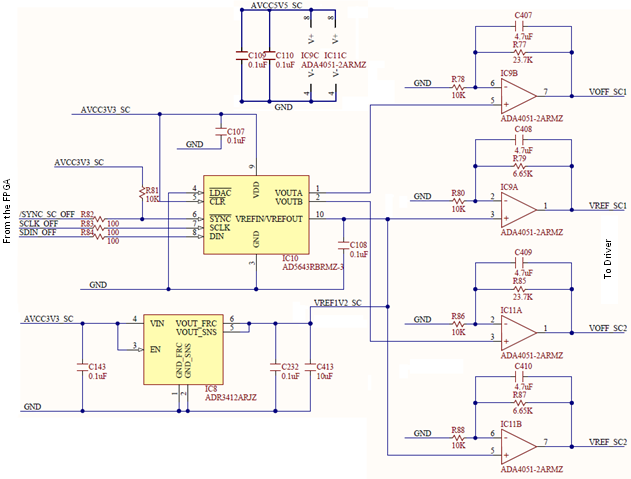 figure_5._scope_reference_and_offset
figure_5._scope_reference_and_offset
2.4. Scope Driver
ADA4940 ADC driver features:
- Small signal bandwidth: 260 MHz
- Extremely low harmonic distortion: -122 dB THD at 50 kHz, -96 dB THD at 1 MHz
- Low input voltage noise: 3.9 nV/√Hz
- 0.35 mV maximum offset voltage
- Settling time to 0.1%: 34 ns
- Rail-to-rail output
- Adjustable output common-mode voltage
- Flexible power supplies: 3 V to 7 V(LFCSP)
- Ultra-low power: 1.25mA
IC2 (Fig. 6) is used for:
- Driving the differential inputs of the ADC (with low impedance outputs)
- Providing the common mode voltage for the ADC
- Adding the offset (for vertical position on the scope). VREFSC1 is constant at midrange of VOFFSC1. This way, the added offset can be either positive or negative.
- ADC protection by clamping the output signals. Protection is important since IC2 is supplied ±3.3V, while the ADC inputs only support -0.1…2.1V. The IC2A constant output signals act as clamping voltages for the Schottky diodes D1, D2.
ADA4940 is supplied ±3.3V. The common mode voltage range is:
$$-3.5V<V_{+ADA4940} = V_{-ADA4940} < 2.1V \label{12}\tag{12}$$
The signal gain is:
$$\frac{V_{ADCdiff}}{V_{bufdiff}}=\frac{R_9}{R_8}=\frac{R_{17}}{R_{16}}=1.77\label{13}\tag{13}$$
The offset gain is:
$$\frac {V_{ADCdiff}}{V_{offSC} - V_{refSC}} = \frac {R_9}{R_3} = \frac {R_{17}}{R_{22}} = 1 \label{14}\tag{14}$$
The common mode gain is:
$$\dfrac{V_{CM}}{V_{ADCP}+V_{ADCN}/2}=1\label{15}\tag{15}$$
The clamping voltages are:
$$V_{Out-IC2A}=V_{CM}-\frac{AVCC1V8}{2}\cdot\frac{R_{23}}{R_{25}} = 0.9V-\frac{1.8V}{2}\cdot\frac{4.99K}{6.34K}=0.2V\label{16}\tag{16}$$
$$V_{Out+IC2A}=V_{CM}-\frac{AVCC1V8}{2}\cdot\frac{R_{23}}{R_{25}} = 0.9V+\frac{1.8V}{2}\cdot\frac{4.99K}{6.34K}=1.6V\label{17}\tag{17}$$
D1, D2 clamp the VADC signals to the protected levels of:
$$-0.1V<V_{+ADA4940}=V_{-ADA4940}<1.9V\label{18}\tag{18}$$
2.5. Clock Generator
A precision oscillator (IC31) generates a low jitter, 20 MHz clock (see Fig. 8).
The ADF4360-9 Clock Generator PLL with Integrated VCO is configured for generating a 200 MHz differential clock for the ADC and a 100 MHz single-ended clock for the DAC.
Analog Devices ADIsimPLL software was used for designing the clock generator (see Fig. 7). The PLL filter is optimized for constant frequency (low Loop Bandwidth = 50 kHz and Phase Margin = 60°). Simulation results are shown below. The Phase jitter using a brick wall filter (10.0 kHz to 100 kHz) is 0.04° rms.
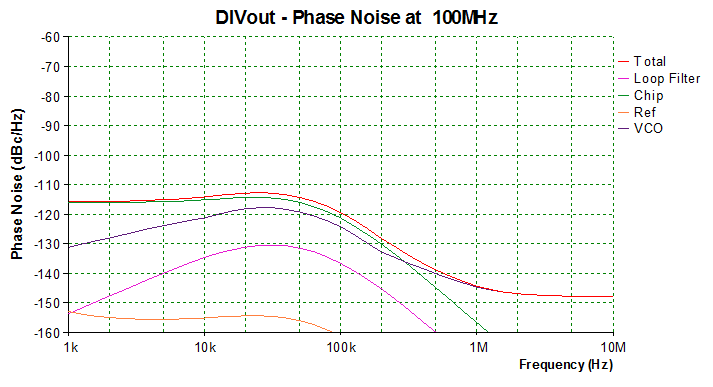 figure_7._phase_noise_figure_for_the_clock_generator
figure_7._phase_noise_figure_for_the_clock_generator
2.6. Scope ADC
2.6.1. 模拟部分
Analog Discovery 2 采用了双通道、高速、14位、105Msps ADC(型号为AD9648), 如图图9 .
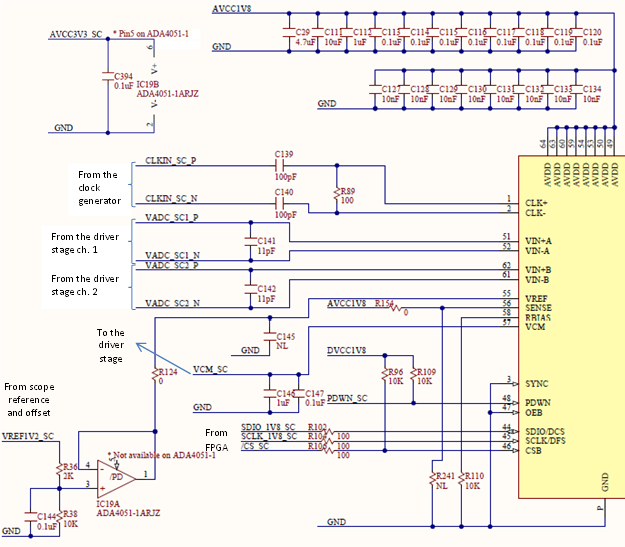 figure_9._adc_-_analog_section
figure_9._adc_-_analog_section
AD9648的主要性能:
- SNR = 74.5dBFS @70 MHz
- SFDR =91dBc @70 MHz
- 低功耗: 78mW/ADC通道 @ 125MSPS
- 650MHz差分模拟输入带宽
- 中频取样频率到200MHz
- 片上电压基准和取样保持电路
- 2Vp-p差分模拟输入
- DNL = ±0.35 LSB
- 可选串行端口控制
- 偏移二进制, gray码, 或2的补码数据格式
- 可选的时钟占空比稳定器
- 输入时钟可以整数(1到8)分频
- 可选数据输出复用
- 内建可选的数字测试模式发生器
- 节能断电模式
- 可以编程的时钟/数据对齐的数据时钟输出
The differential inputs are driven via a low-pass filter comprised of C141 together with R10 through R13, in the buffer stage. The differential clock is AC-coupled and the line is impedance matched. The clock is internally divided by two for operating at a constant 100 MHz sampling rate. An external reference voltage is used, buffered by IC 19. The ADC generates the common mode reference voltage (VCM_SC) to be used in the buffer stage.
差分输入电压范围:
$$-1V<V_{ADC\;diff}<1V\label{19}\tag{19}$$
2.6.2. Digital Section
The digital stage of the ADC and the corresponding FPGA bank are supplied at 1.8V.
To minimize the number of used FPGA pins; a multiplexed mode is used, to combine the two channels on a single data bus. CLKOUTSC is provided to the FPGA for synchronizing data (see Fig. 10).
 figure_10._adc_-_digital_section
—-
===== 2.7. Scope Signal Scaling =====
Combining Gain equations \ref{3}, \ref{5}, \ref{9}, \ref{13}, \ref{14}, and \ref{15} from previous chapters, the total scope gains are:
$$Low \; gain = \frac{V{ADC\;diff}}{V{in\;diff}}=0.034$$
$$High \; gain = \frac{V{ADC\;diff}}{V_{in\;diff}}=0.375\label{20}\tag{20}$$
Combining the ADC input voltage range shown in \ref{19} with $V_{offSC}$ at the midrange of \ref{11} (scope vertical position at 0), the Vin range is:
figure_10._adc_-_digital_section
—-
===== 2.7. Scope Signal Scaling =====
Combining Gain equations \ref{3}, \ref{5}, \ref{9}, \ref{13}, \ref{14}, and \ref{15} from previous chapters, the total scope gains are:
$$Low \; gain = \frac{V{ADC\;diff}}{V{in\;diff}}=0.034$$
$$High \; gain = \frac{V{ADC\;diff}}{V_{in\;diff}}=0.375\label{20}\tag{20}$$
Combining the ADC input voltage range shown in \ref{19} with $V_{offSC}$ at the midrange of \ref{11} (scope vertical position at 0), the Vin range is:
$$at \; low \; gain: -30V<V_{in\;diff}<28.6V$$ $$at \; high \; gain: -2.7V<V_{in\;diff}<2.6V\label{21}\tag{21}$$
To cover component value tolerances and to allow software calibration, only the ranges below are specified.
$$at \; low \; gain: -25V<V_{in\;diff}<25V$$ $$at \; high \; gain: -2.5V<V_{in\;diff}<2.5V\label{22}\tag{22}$$
With the 14-bit ADC, the absolute resolution of the scope is:
$$at \; low \; gain: \frac{58.6V}{2^{14}}=3.58mV$$ $$at \; high \; gain: \frac{5.3V}{2^{14}}=0.32mV\label{23}\tag{23}$$
The effect of the offset setting (scope vertical position) can be calculated from \ref{10}, \ref{11} and \ref{14}:
$$-2V<V_{offSC}-V_{refSC}<2.044V\label{24}\tag{24}$$
The vertical position setting moves the signals vertically on the scope screen (relative to vertical screen center) by $V_{off eq in}$:
$$at \; low \; gain: -59.3V<V_{off\;eq\;in}<59.3V$$ $$at \; high \; gain: -5.39V<V_{off\;eq\;in}<5.39V\label{25}\tag{25}$$
The above adds an equivalent offset voltage $V_{off eq in}$ to $V_{in diff}$, translating the ranges in \ref{21} and \ref{22} by $V_{off eq in}$ , up to the limits in \ref{25}.
Equations \ref{2}, \ref{7}, \ref{8}, \ref{12}, and \ref{19} show signal range boundaries for keeping ICs in the input/output voltage ranges. Combining these with the gain equations, the overall linear scope operation range is shown Figs. 11 & 12. Each equation is represented by a closed polygon. Each figure is shown at the full range and at a detailed range. Separate figures are shown for low-gain and for high-gain. The right hand diagrams use $V_{in diff}$ and $V_{in CM}$ coordinates while left hand ones use $V_{inP}$ and $V_{inN}$ coordinates.
To be visible on the scope screen and not distorted, a signal should be included in all the solid line polygons of a figure (linear range = geometrical intersection of the surfaces).
Only the differential input voltage is shown on the scope screen. The common mode voltage information is removed by the differential structure of the Analog Discovery 2 scope. A signal overpassing the linear range will be distorted on the scope screen, i.e. the graphical representation will be clamped. In the diagrams below, a signal outside the linear range will be clamped to the closest point in the linear range. The clamping point is not necessarily at the scope screen top or bottom edge, as explained below.
 figure_11._scope_input_signal_range._scale_-_low_gain_in_terms_of_-_vinp_and_vinn_left_vindiff_and_vincm_right_._size_-_full_range_up_detail_down
figure_11._scope_input_signal_range._scale_-_low_gain_in_terms_of_-_vinp_and_vinn_left_vindiff_and_vincm_right_._size_-_full_range_up_detail_down
The dashed rectangles represent the display area on the scope screen. There are three dashed rectangles in each diagram: the middle one corresponds to the vertical position set to 0 (VoffSc = 2.022V in equation \ref{11}. The left one shows the display area when vertical position is set to maximum (VoffSc = 4.044V), and the right one corresponds to the minimum (negative) vertical position (VoffSc = 0V). Any intermediate vertical position is possible, moving the displayable area (virtual dashed rectangle) to any intermediate position. A signal crossing the long side of the dashed rectangle exceeds the displayable input voltage range causing the ADC to saturate (either at zero or at Full Scale). This is represented on the scope screen with dashed line warning to the user.
 figure_12._scope_input_signal_range._scale_-_high_gain_in_terms_of_-_vinp_and_vinn_left_vindiff_and_vincm_right_._size_-_full_range_up_detail_down
figure_12._scope_input_signal_range._scale_-_high_gain_in_terms_of_-_vinp_and_vinn_left_vindiff_and_vincm_right_._size_-_full_range_up_detail_down
A signal keeping within the dashed rectangle but crossing any solid line overrides electrical limits of intermediate circuits in the signal path (see the legend of the figures). This results in distorting the signal without saturating the ADC. The software has no information about this situation and cannot warn the user with specific signal representation. It is the user’s responsibility to understand and avoid such situations.
For low gain (Fig. 11), the simple condition to stay in the linear range is to keep both positive and negative inputs $V_{inP}$, $V_{inN}$ in the ±26V range (as shown by equation \ref{2}).
For high gain (Fig. 12), by combining equations \ref{7} and \ref{5}, both positive and negative inputs in must stay in the range:
$$-26V<V_{inP},V_{inN}<10V\label{26}\tag{26}$$
Additionally, the differential input signal (combined with the equivalent offset voltage – vertical position) is visible only within the range:
$$-7.5V<V_{inDiff}<7.5V\label{27}\tag{27}$$
Note the difference between typical parameter values considered by the figures and the safer min/max values used for the equations.
Figure 13 shows an example of a signal distorted due to a common mode input voltage that is too large. The grey line is the reference, not distorted, signal. The differential input voltage is a 4Vpp triangle on top of a -5V DC component. The common mode input voltage is 10V. The vertical position of the scope is set to 5V and high gain is selected. The yellow line shows an identical signal, except the common mode input voltage is 15V.
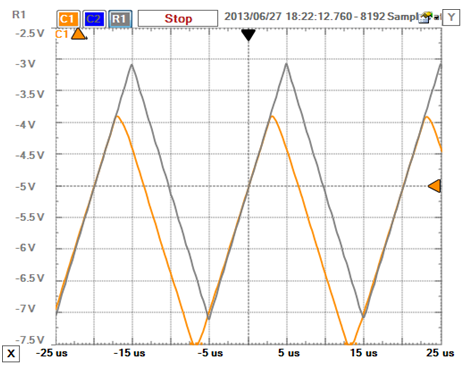 figure_13._common_mode_input_voltage_limitation
figure_13._common_mode_input_voltage_limitation
2.8 Scope Spectral Characteristics
Figure 14 shows a typical spectral characteristic of the scope. An Agilent 3320A 20 MHz Function/Arbitrary Waveform Generator was used to generate the input signal of 1VRMS. The signal swept from 100 Hz to 30 MHz. A coax cable and a Digilent Discovery BNC adapter were used to connect the input signal to the Discovery inputs.
The Network Analyzer was used, the WaveGen was set to External, the Gain was set at x10 (high-gain) for the upper figure, and x0.1 (low-gain) for the lower one. For both scales, the 3dB bandwidth is 30 MHz+. The 0.5dB bandwidth is 10 MHz and the 0.1dB bandwidth is 5 MHz. The standard -3dB bandwidth definition is derived from filter theory. At cutout frequency, the scope attenuates the spectral components by 0.707, assuming an error of ~30%, way too high for a measuring instrument. The bandwidth with a specified flatness is useful to better define the scope spectral performances. The Analog Discovery 2 exhibits 10 MHz @ 0.5dB, meaning that a 10 MHz sinusoidal signal is shown with a flatness error of a max 5.6%. 5 MHz @ 1dB means that a 5 MHz sinusoidal signal is shown with a flatness error of a max 1.5%.
 figure_14._scope_spectral_characteristic_diagram._low_gain_up_high_gain_down
figure_14._scope_spectral_characteristic_diagram._low_gain_up_high_gain_down
As shown above, the measurements in Fig. 14 were taken with a coax cable and a Digilent Discovery BNC adapter. This is the optimal setup that allows maximal Analog Discovery spectral performance. The wire kit included with the Analog Discovery 2 is a cheap, easy-to-use probing solution. However, the wire kit reduces the bandwidth of the scope and is susceptible to inducing noise and crosstalk from adjacent circuits. Fig. 21 shows the spectral characteristic diagram for the AWG connected to the scope with the wire kit.
3. Arbitrary Waveform Generator
3.1. AWG DAC
The Analog Devices AD9717 dual, low-power 14-bit TxDAC digital-to-analog converter is used to generate the wave (Fig. 15). The main features are:
- Power dissipation @ 3.3V, 2 mA output: 86 mW @ 125 MSPS, sleep mode: <3 mW @ 3.3V
- Supply voltage: 1.8V to 3.3V
- SFDR to Nyquist: 84 dBc @ 1 MHz output, 75 dBc @ 10 MHz output
- AD9717 NSD @ 1 MHz output, 125 MSPS, 2 mA: −151 dBc/Hz
- Differential current outputs: 1 mA to 4 mA
- CMOS inputs with single-port operation
- Output common mode: 0 to 1.2 V
- Small footprint, 40-lead LFCSP RoHS-compliant package
The parallel Data Bus and the SPI configuration bus are driven by the FPGA. The single ended 100 MHz clock is provided by the clock generator. External Vref1VAWG reference voltage is used. The output currents (IoutAWGxP and _N) are converted to voltages in the I/V stage. The Full Scale is set via the FSADJx pins (see Fig. 16). The ADG787 2.5Ω CMOS Low Power Dual 2:1 MUX/DEMUX is used to connect $text_r{set}}$ of either 8kΩ (for high gain) or 32kΩ (for low gain) from FSADJx pin to GND.
The ADG787 features:
- −3 dB bandwidth, 150 MHz
- Single-supply 1.8V to 5.5V operation
- Low on resistance: 2.5 Ω typical
3.2. AWG Reference and Offset
As shown in Fig. 17, the reference voltage for the AWG is generated by IC42 (ADR3412ARJZ). A divided version is provided to the DAC:
$$V_{ref1V\_AWG}=V_{ref1V2\_AWG} \cdot \frac{R_{41}}{R_{39}+{R_{41}}}=1V\label{28}\tag{28}$$
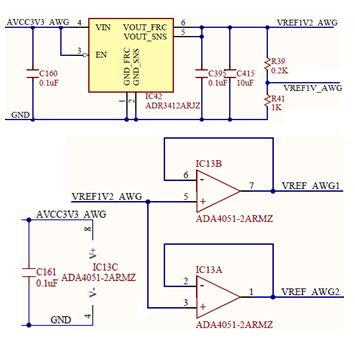 figure_17._dac_-_reference_voltages
figure_17._dac_-_reference_voltages
Buffered versions are provided to the I/V stages and individually for each AWG channel to minimize crosstalk.
The Full Scale DAC output current is:
$$I_{outAWGFS}=32 \cdot \frac{V_{ref1V\_AWG}}{R_{set}}\label{29}\tag{29}$$
For high-gain:
$$I_{outAWGFS\_HG}=32 \cdot \frac{1V}{8k \Omega}=4mA\label{30}\tag{30}$$
For low-gain:
$$I_{outAWGFS\_HG}=32 \cdot \frac{1V}{32k \Omega}=1mA\label{31}\tag{31}$$
An AD5645R Quad 14-bit nanoDAC generates the offset voltages to add a DC component to the AWG output signal (Fig. 18). The same circuit also generates VSET+ USR and VSET- USR, used to set the +/- user supply voltages.
- Low power, smallest quad 14-bit nanoDAC
- 2.7 V to 5.5 V power supply
- Monotonic by design
- Power-on reset to zero scale/midscale (important for starting the AWG with 0 DC component)
The Full Scale voltage of all IC43 outputs is:
$$V_{offAWGFS}=V_{SET\_USRFS}=V_{ref1V2AWG}=1.2V\label{32}\tag{32}$$
3.3. AWG I/V
IC 15 in Fig. 19 converts the DAC output currents to a bipolar voltage.
Important AD8058 features:
- Low cost
- 325 MHz, −3 dB bandwidth (G = +1)
- 1000 V/μs slew rate
- Gain flatness: 0.1 dB to 28 MHz
- Low noise: 7 nV/√Hz
- Low power: 5.4 mA/amplifier typical @ 5 V
- Low distortion: −85 dBc@5MHz, RL=1kΩ
- Wide supply range from 3 V to 12 V
- Small packaging
$$V_{Audio}=I_{outAWGP} \cdot R_{148}-I_{outAWGN} \cdot R_{142}=$$ $$=( 1-2 \cdot \{ A_U \} ) \cdot I_{outAWGFS} \cdot R_{142}=\{ A_b \} \cdot I_{outAWGFS} \cdot R_{142}\label{33}\tag{33}$$
Where:
$$\left\{ {{A_U}} \right\} = \frac{D}{{{2^N}}} \in \left[ {\left. {0 \ldots 1} \right)} \right.;\; - \;normalized\;unipolar\;DAC\;input\;number$$
$$\left\{ {{A_B}} \right\} = \left( {1 - 2 \cdot \left\{ {{A_U}} \right\}} \right) \in \left[ {\left. { - 1 \ldots 1} \right)} \right.;\; - \;normalized\;bipolar\;DAC\;input\;number\;\left( {binary\;offset} \right)$$
$$D \in \left[ {\left. {0 \ldots {2^{14}}} \right)} \right. = \left[ {0 \ldots {2^{14}} - 1} \right];\; - \;integer\;unipolar\;DAC\;input\;number\label{34}\tag{34}$$
The Voltage range extends between:
$$ - V_{AudioFS} \le V_{Audio} < - V_{AudioFS}\label{35}\tag{35}$$
Where (for high gain, respectively, low gain):
$$V_{AudioFS\;HG}=I_{outAWGFS\;HG} \cdot R_{142}=496mV$$ $$V_{AudioFS\;LG}=I_{outAWGFS\;LG} \cdot R_{142}=124mV\label{36}\tag{36}$$
//{{anchor:figure_19:Figure 19. AWG I/V and out.}}//
3.4. AWG Out
IC16 in Fig. 19 is the output stage of the AWG. AD8067 features:
- FET input: 0.6 pA input bias current
- Stable for gains ≥8 for High-Capacitive Load
- High speed: 54 MHz@−3 dB (G = +10)
- 640 V/µs slew rate
- Low noise:6.6 nV/√Hz; 0.6 fA/√Hz
- Low offset voltage (1.0 mV max)
- Rail-to-rail output
- Low distortion: SFDR 95 dBc @ 1 MHz
- Low power: 6.5 mA typical supply current
- Low cost; Small packaging: SOT-23-5
Matching the impedances in the inverting and non-inverting inputs of IC16:
$$\frac{1}{{{{\mathbf{R}}_{140}}}} + \frac{1}{{{{\mathbf{R}}_{141}}}} + \frac{1}{{{{\mathbf{R}}_{144}}}} = \frac{1}{{{{\mathbf{R}}_{147}}}} + \frac{1}{{{{\mathbf{R}}_{149}}}}\label{37}\tag{37}$$
$$V_{outAWG}=-V_{Audio} \cdot \frac{R_{141}}{R_{144}}+\left(2 \cdot V_{offAWG}-V_{ref1V2AWG}\right) \cdot \frac{R_{141}}{R_{140}}\label{38}\tag{38}$$
The first term in equation \ref{38} represents the actual wave amplitude, with a range of:
$$ - 5.45V < - 5V < V_{ACoutAWG\;HG} < 5V < 5.45V$$ $$ - 1.36V < 1.25V < V_{ACoutAWG\;LG} < 1.25V < 1.36V\label{39}\tag{39}$$
Low-gain is used to generate low amplitude signals with improved accuracy. Any amplitude of the output signal is derivable by combining LowGain/HighGain setting (rough) with the digital signal amplitude (fine).
With the 14-bit DAC, the absolute resolution of the AWG AC component is:
$$at\;Low\;Gain:\;\;\;\frac{{2.72V}}{{{2^{14}}}} = 166\mu V$$ $$at\;High\;Gain:\;\;\;\;\;\frac{{10.9V}}{{{2^{14}}}} = 665\mu V\label{40}\tag{40}$$
The second term in equation \ref{38} shows the DC component (AWG offset), with a range of (for either LowGain or HighGain):
$$ - 5.5V < 5V < V_{DCoutAWG} < 5V < 5.5V\label{41}\tag{41}$$
AD8067 is supplied with $\pm 5.5V$; to avoid saturation the user should keep the sum of AC and DC components in \ref{38} to:
$$ - 5.5V < 5V < V_{outAWG} < 5V < 5.5V\label{42}\tag{42}$$
Only bolded ranges are used in equations \ref{39}, \ref{41}, and \ref{42}, for providing tolerance margins.
The R145 PTC thermistor provides thermal protection in case of an output shortcut.
3.5. Audio
A stereo audio output combines the two AWG channels (Fig. 20). AD8592 was used for its features:
- Single-supply operation: 2.5 V to 6 V
- High output current: ±250 mA
- Low shutdown supply current: 100 nA
- Low supply current: 750 μA/Amp
- Very low input bias current
A single 3.3V supply is used.
$$V_{outIC18}=-2 \cdot V_{Audio}+1.5V\label{43}\tag{43}$$
The first term in equation \ref{43} is the audio signal. The second term is the common mode DC component, removed by AC coupling.
The audio signal range is:
$$V_{AudioJack}=-2 \cdot V_{Audio}$$ $$-992mV < V_{AudioJack} < 992mV \left( High\;Gain \right)$$ $$-248mV < V_{AudioJack} < 248mV \left( Low\;Gain \right)\label{44}\tag{44}$$
3.6. AWG Spectral Characteristics
Figure 21 shows the typical spectral characteristic of the AWG. In the first experiment (up), a coax cable and a Digilent Discovery BNC adapter were used to connect the AWG signal to the Scope inputs. For the second experiment (down), the AWG was connected to the scope inputs via the Analog Discovery wire kit. The Analog Discovery 2 Scope hardware was considered a reference for the experiments above because it has preferred spectral characteristics to the AWG.
The Network Analyzer virtual instrument in WaveForms is used to perform synchronized signal synthesis and acquisition. It takes control of channel 1 of AWG and of both scope channels. Start/Stop frequencies are set to 100 Hz/25 MHz, respectively. Sinus amplitude is set to 1V. The characteristic is built in 100 steps. The 3dB bandwidth is 12 MHz with the coax cable and 9 MHz with the wire kit. The 0.5dB bandwidth is 4 MHz with the coax cable and 2.9 MHz with the wire kit. The 0.1dB is 1 MHz with the coax cable and 800 kHz with the wire kit.
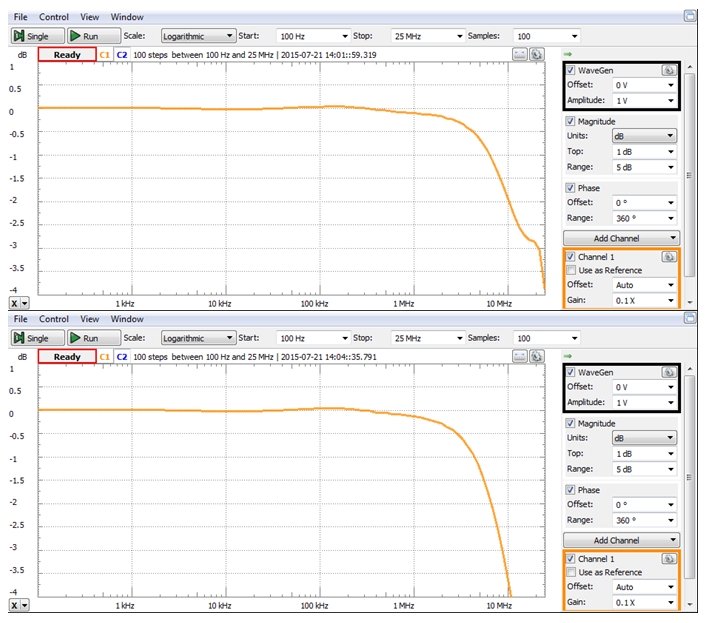 figure_21._awg_spectral_characteristics._with_analog_discovery_bnc_adapter_and_bnc_cable_from_awg_to_scope_up_._with_the_wire_kit_down
figure_21._awg_spectral_characteristics._with_analog_discovery_bnc_adapter_and_bnc_cable_from_awg_to_scope_up_._with_the_wire_kit_down
4. Calibration Memory
The analog circuitry described in previous chapters includes passive and active electronic components. The datasheet specs show parameters (resistance, capacitance, offsets, bias currents, etc.) as typical values and tolerances. The equations in previous chapters consider typical values. Component tolerances affect DC, AC, and CMMR performances of the Analog Discovery 2. To minimize these effects, the design uses:
- 0.1% resistors and 1% capacitors in all the critical analog signal paths
- Capacitive trimmers for balancing the Scope Input Divider and Gain Selection
- No other mechanical trimmers (as these are big, expensive, unreliable and affected by vibrations, aging, and temperature drifts)
- Software calibration, at manufacturing
- User software calibration, as an option
A software calibration is performed on each device as a part of the manufacturing test. AWG signals are passed to a reference instrument and reference signals are connected to the Scope inputs. A set of measurements is used to identify all the DC errors (Gain, Offset) of each analog stage. Correction (Calibration) parameters are computed and stored in the Calibration Memory, on the Analog Discovery 2 device, as Factory Calibration. The WaveForms software allows the user performing an in-house calibration and overwrite the Calibration Data. Returning to Factory Calibration is always possible.
The WaveForms Software reads the calibration parameters from the connected Analog Discovery 2 and uses them to correct both generated and acquired signals.
5. Digital I/O
Figure 22 shows half of the Digital I/O pin circuitry (the other half is symmetrical). J3 is the Analog Discovery 2 user signal connector.
General purpose FPGA I/O pins are used for Analog Discovery 2 Digital I/O. FPGA pins are set to SLOW slew rate and 4mA drive strength, with no internal pull.
PTC thermistors provide thermal protection in case of shortcuts. Schottky Diodes double the internal FPGA ESD protection diodes for increasing the acceptable current in case of overvoltage. Nominal resistance of the PTCs (220Ω) and parasitical capacitance of the Schottky diodes (2.2pF) and FPGA pins (10pF) limit the bandwidth of the input pins. For output pins, the PTCs and the load impedance limit the bandwidth and power.
Input and output pins are LVCMOS3V3. Inputs are 5V tolerant. Overvoltage up to ±20V is supported.
6. 电源和控制
此部分为所有的电源监测和控制电路,内部的电源以及用户电源。
6.1. USB Power Control
As shown in Fig. 23, the Analog Discovery 2's power can be supplied either from the USB port (VBUS) or from an external power supply (J4 connector).
The external power input is protected against reverse voltage; Q4 turns OFF if a floating power supply with negative polarity on central pin of J4 is used. However, the device is not protected for a very unlikely use case:
- Analog Discovery 2 connected to the USB port of a PC which has GND connected to EARTH
- External power supply with negative polarity on central pin of J4 and with exterior pin connected to EARTH.
In this case, the external EARTH loop acts as a shortcut of Q4.
ADCMP671 is a window comparator with the following features:
- Window monitoring with minimum processor I/O
- Individually monitoring N rails with only N + 1 processor I/O
- 400 mV ± 0.275% threshold at VDD = 3.3 V, 25°C
- Supply range: 1.7 V to 5.5 V
- Low quiescent current: 8.55 μA maximum
- Input range includes ground
- Internal hysteresis: 9.2 mV typical
- Low input bias current: ±2.5 nA maximum
- Open-drain outputs
- Power good indication output
- Designated over voltage indication output
- Low profile (1 mm), 6-lead TSOT package
IC48 drives PWRGD output HIGH (turning IC26 ON) when Vext is in the range:
$$4.11V=400mV \cdot \frac {R_{248} + R_{249}+R_{273}}{R_{249} + R_{273}} < V_{ext} < 400mV \cdot \frac {R_{248} + R_{249} + R_{273}}{R_{273}}=5.76V\label{45}\tag{45}$$
The Analog Discovery 2 exhibits two main powering modes: USB and External. Temporary modes (Racing OFF, USB OFF and Racing) are explained here for design clarifications, but have no importance for the user observed behavior.
- Racing OFF – immediately after reset, before FPGA is programmed, if an external power supply is attached and in the right range (PWRGD = HIGH).
- USB OFF – immediately after reset, before FPGA is programmed, if external power supply is missing or out-of-range (PWRGD = LOW).
- USB – all the power is drained from the Vbus (IC21 = ON, IC26 = OFF). The external power supply is either missing or out of the right voltage range. The power available for both User Supplies is limited to 0.7W.
- Racing – when external power supply is in the right voltage range (PWRGD = HIGH), before WaveForms stops the USB Power Controller. During racing mode, both USB Power Controller (IC21) and External Power controller (IC26) are ON, the device drains power from whatever supply has a higher voltage (D28 and D29 work as a maxim voltage detector). The Racing mode is temporary, it ends when the FPGA is configured and communicates with the WaveForms software. During Racing mode, the power available for User Supplies is limited.
- External – the device is powered from an external supply (via the 5V DC connector and IC26). Vext is in the range shown by equation \ref{45} (PWRGD = HIGH, and WaveForms already stopped the USB Power Controller (IC21). The User Supplies current and power limits are increased to 700mA or 2.1W each. The only circuit still supplied from the USB VBUS is the USB controller (IC41).
At Power ON, the FPGA is not programmed, ENVBUS is HiZ, the pulldown resistor R246 turns Q1 OFF, IC21 is ON via R174. The Analog Discovery 2 starts in USB OFF mode (when PWRGD = LOW) or Racing OFF mode (when PWRGD = HIGH). The WaveForms software first configures the FPGA, and the device turns into USB or Racing mode, depending on presence/absence of correct external supply voltage. The FPGA continuously monitors the voltage at the 5V DC connector. When detecting the Racing mode (PWRGD = HIGH), WaveForms sends the command to drive ENVBUS HIGH, turning the USB Power Controller (IC21) OFF, thus switching to External mode.
If external Power Supply is attached after WaveForms started and runs several instruments, the device steps seamlessly trough USB → Racing → External modes. Running instruments are not affected, except User Supplies get more available power.
However, removing the external power supply during External mode is not seamless. Only the USB controller keeps working (as supplied from the USB port). The FPGA gets unpowered and loses configuration data. The device stops all the instruments, EN_VBUS go HiZ, which leads to the USB OFF mode. WaveForms will prompt the user to select the device, which will re-program the FPGA. All the instruments can then be run, in the USB mode.
An ADM1177 Hot Swap Controller and Digital Power Monitor with Soft Start Pin is used to provide USB power compliance during USB and Racing modes (IC21 in Fig. 23).
Remarkable ADM1177 features are:
- Safe live board insertion and removal
- Supply voltages from 3.15 V to 16.5 V
- Precision current sense amplifier
- 12-bit ADC for current and voltage read
- Adjustable analog current limit with circuit breaker
- ±3% accurate hot swap current limit level
- Fast response limits peak fault current
- Automatic retry or latch-off on current fault
- Programmable hot swap timing via TIMER pin
- Soft start pin for reference adjustment and programming of initial current ramp rate
- I2C fast mode-compliant interface (400 kHz maximum)
When enabled, (in USB or Racing modes), IC21 limits the current consumed from the USB port to:
$${I_{limit}} = \frac{{100mV}}{{{R_{173}}}} = \frac{{100mV}}{{0.1\Omega }} = 1A\label{46}\tag{46}$$
For a maximum time of:
$$t_{fault}=21.7 \left[ ms / \mu F \right] \cdot C_{80}=21.7 \left[ ms / \mu F \right] \cdot 0.47\mu F =10.2ms\label{47}\tag{47}$$
If the consumed current does not fall below ${I_{limit}}$ before ${t_{fault}}$, IC21 turns off Q2A. A hot swap retry is initiated after:
$$t_{cool}=550 \left[ ms / \mu F \right] \cdot C_{80} = 550 \left[ \frac{ms}{\mu F} \right] \cdot 0.47 \mu F = 258.5ms\label{48}\tag{48}$$
To avoid high inrush currents at hot swap, Soft Start circuitry limits the current slope to:
$$\frac {dI_{limit}}{dt} = \frac {10 \mu A}{C_{81}} \cdot \frac {1}{10 \cdot R_{173}} =212 \frac {mA}{ms} \label{49}\tag{49}$$
If the current drops below $\;{I_{limit}}$ before ${t_{fault}}$, normal operation begins.
Similarly, IC26 (in Racing or External modes), limits the current consumed from the external power supply to:
$${I_{limit}} = \frac {100mV}{R_{247}} = \frac {100mV}{0.036 \Omega} = 2.78A\label{50}\tag{50}$$
${t_{fault}}$ and ${t_{cool}}$ are same as for IC21, and the current slope limit is:
$$\frac {dI_{limit}}{dt} = \frac{10\mu A}{C_{432}} \cdot \frac{1}{10 \cdot R_{247}}=591 \frac{mA}{ms}\label{51}\tag{51}$$
The Analog Discovery 2 user pins are overvoltage protected. Overvoltage (or ESD) diodes short when a user pin is overdriven by the external circuitry (Circuit Under Test), back powering the input/output block and all the circuits sharing the same internal power supply. If the back-powered energy is higher than the used energy, the bi-directional power supply recovers the difference and delivers it to the previous node in the power chain. Eventually, the back-powering energy could arrive to the USB VBUS, raising the voltage above the 5V nominal value. D28 in Fig. 23 protects the PC USB port against such a situation.
6.2. Analog Supplies Control
During USB mode, the FPGA constantly reads from IC21 the current value through R173. (Optionally displayed on Main Window/Discovery or Status button). A warning is generated when exceeding 500mA (Status: OC = Over Current). If a value of 600mA is reached and Overcurrent protection is enabled (MainWindow/Device/Settings/Overcurrent protection), WaveForms turns off IC20 (ADP197) shown in Fig. 24 and IC27 shown Fig. 25, disabling the analog blocks and user power supplies.
ADP197 main features:
- Low RDSon of 12mΩ
- Low input voltage range: 1.8V to 5.5V
- 1.2V logic compatible enable logic
- Overtemperature protection
- Ultra-small 1.0mmX1.5mm, 6 ball, 0.5mm pitch WLCSP
//{{anchor:figure_24:Figure 24. Analog Supplies control.}}//
6.3. User Supplies Control
IC27 in Fig. 25 controls the power available for the user supplies. ADM1270 was selected for its main features:
- Controls supply voltages from 4 V to 60 V
- Gate drive for low voltage drop reverse supply protection
- Gate drive for P-channel FETs
- Inrush current limiting control
- Adjustable current limit
- Foldback current limiting
- Automatic retry or latch-off on current fault
- Programmable current-limit timer for safe operating area (SOA)
- Power-good and fault outputs
- Analog undervoltage (UV) and overvoltage (OV) protection
- 16-lead 3x3mm LFCSP package
- 16-lead QSOP package
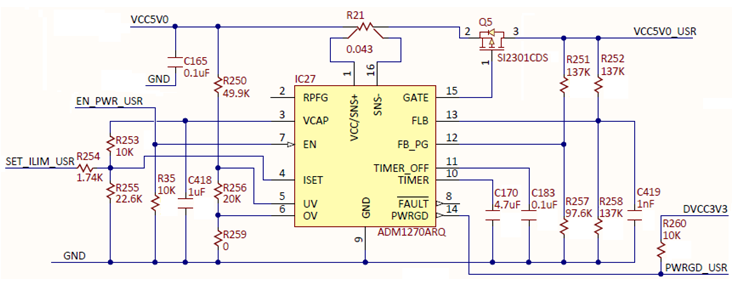 figure_25._user_supplies_control
figure_25._user_supplies_control
IC27 limits the current consumed by both user power supplies together. The WaveForms software commands the FPGA to change the limit, depending on the power mode.
During USB and Racing modes, SETILIMUSR pin is driven LOW by the FPGA. The voltage at the ISET pin of IC27 is:
$${V_{Iset}} = \frac{{\frac{{{V_{cap}}}}{{{R_{253}}}}}}{{\frac{1}{{{R_{253}}}} + \frac{1}{{{R_{254}}}} + \frac{1}{{{R_{255}}}}}} = \frac{{\frac{{3.6V}}{{10k\Omega }}}}{{\frac{1}{{10k\Omega }} + \frac{1}{{1.74k\Omega }} + \frac{1}{{22.6k\Omega }}}} = 0.5V\label{52}\tag{52}$$
The current limit is set to:
$$I_{limit}= \frac{V_{Iset}}{40 \cdot R_{21}} = \frac{0.5V}{40 \cdot 0.043 \Omega} = 290mA\label{53}\tag{53}$$
During External and OFF modes, SETILIMUSR pin is driven HiZ by the FPGA. The voltage at the ISET pin of IC27 is:
$$V_{Iset}= \frac {V_{cap} \cdot R_{255}}{R_{253} + R_{255}} = \frac{3.6V \cdot 22.6k \Omega }{10k \Omega + 22.6k \Omega} = 2.5V\label{54}\tag{54}$$
The current limit is set to:
$$I_{limit}= \frac {V_{Iset}}{40 \cdot R_{21}} = \frac {2.5V}{40 \cdot 0.043 \Omega} = 1.45A\label{55}\tag{55}$$
In both cases, ${I_{limit}}$ is allowed for a maximum time of:
$$t_{fault}=21.7 \left[ ms / \mu F \right] \cdot C_{170} = 21.7 \left[ ms / \mu F \right] \cdot 4.7 \mu F = 102ms\label{56}\tag{56}$$
If the consumed current does not fall below ${I_{limit}}$ before ${t_{fault}}$, IC21 turns off Q2. A hot swap retry is initiated after:
$$t_{cool}=550 \left[ ms / \mu F \right] \cdot C_{80} = 550 \left[ ms / \mu F \right] \cdot 4.7 \mu F = 2.585s\label{57}\tag{57}$$
Soft Start is not used; C183 is a No Load.
If the current drops below ${I_{limit}}$ before ${t_{fault}}$, normal operation begins.
The current limited by equations \ref{53} and \ref{55} is shared by both positive and negative user power supplies. After considering the efficiency of the user supply stages, about 100mA is available for user in both supplies together, in USB Only mode. In External mode, the current/power limit for user is set in the User Voltage Supplies, as explained below.
6.4. User Voltage Supplies
The user power supplies (Fig. 26) use ADP1612 Switching Converter in Buck-Boost DC-to-DC topology. Main features:
- 1.4A current limit
- Minimum input voltage 1.8V
- Pin-selectable 650 kHz or 1.3 MHz PWM frequency
- Adjustable output voltage up to 20 V
- Adjustable soft start
- Undervoltage lockout
IC46A/B op amps insert the command voltages $V{SET+_USR}$ and $V{SET-_USR}$, respectively, in the feedback loop. Additionally, IC46B introduces the required inversion for the negative supply.
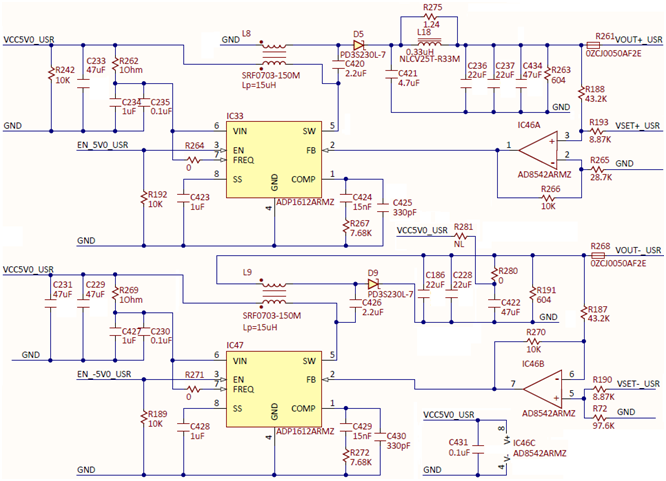 figure_26._user_power_supplies
figure_26._user_power_supplies
Since the op amps are included in negative feedback loops, the input pins voltages are equal:
$${V_{ + IC46A}} = \frac{{\frac{{{V_{OUT + \_USR}}}}{{{R_{188}}}} + \frac{{{V_{SET + \_USR}}}}{{{R_{193}}}}}}{{\frac{1}{{{R_{188}}}} + \frac{1}{{{R_{193}}}}}} = {V_{ - IC46A}} = \frac{{\frac{{{V_{FB}}}}{{{R_{266}}}}}}{{\frac{1}{{{R_{265}}}} + \frac{1}{{{R_{266}}}}}}\label{58}\tag{58}$$
$${V_{ + IC46B}} = \frac{{\frac{{{V_{OUT - \_USR}}}}{{{R_{187}}}} + \frac{{{V_{FB}}}}{{{R_{270}}}}}}{{\frac{1}{{{R_{187}}}} + \frac{1}{{{R_{270}}}}}} = {V_{ - IC46B}} = \frac{{\frac{{{V_{SET - \_USR}}}}{{{R_{190}}}}}}{{\frac{1}{{{R_{72}}}} + \frac{1}{{{R_{190}}}}}}\label{59}\tag{59}$$
The input impedances for the op amps are matched:
$$\frac{1}{{{R_{188}}}} + \frac{1}{{{R_{193}}}} = \frac{1}{{{R_{265}}}} + \frac{1}{{{R_{266}}}}\label{60}\tag{60}$$
$$\frac{1}{{{R_{187}}}} + \frac{1}{{{R_{270}}}} = \frac{1}{{{R_{72}}}} + \frac{1}{{{R_{190}}}}\label{61}\tag{61}$$
The user voltages are:
$$V_{OUT\;+\_USR}=V_{FB} \cdot \frac{R_{188}}{R_{266}} - V_{SET\;+\_USR} \cdot \frac{R_{188}}{R_{193}}=5.33V-4.87 \cdot V_{SET\;+\_USR}\label{62}\tag{62}$$
$$V_{OUT\;-\_USR}=-V_{FB} \cdot \frac{R_{187}}{R_{270}} + V_{SET\;-\_USR} \cdot \frac{R_{187}}{R_{190}}=-5.33V+4.87 \cdot V_{SET\;-\_USR}\label{63}\tag{63}$$
Where:
$${V_{FB}} = 1.235V\;typical\label{64}\tag{64}$$
IC43 (Fig. 18) generates the setting voltages in the range:
$$0 < V_{SET + \_USR},\; V_{SET - \_USR} < 1.2V\label{65}\tag{65}$$
Which would allow output voltages to be set in the ranges:
$$ - 0.51V \le {V_{SET + \_USR}} < 5.33V\label{66}\tag{66}$$
$$0.51V \ge \; V_{SET - \_USR} > - 5.33V\label{67}\tag{67}$$
The margins allow for compensating the components’ tolerances. After calibration, the WaveForms SW only allows the ranges 0 to +/-5V respectively. Even so, output voltages below absolute value of 0.5V are not guaranteed. With light loads, such voltages might exhibit significant ripple (~15mV).
Each supply can be disabled by the FPGA.
6.5. Internal Power Supplies
6.5.1. Analog Supplies
Analog supplies need to have very low ripple to prevent noise from coupling into analog signals. Ferrite beads are used to filter the remaining switching noise and to separate the power supplies that go to the main analog circuit blocks, to avoid crosstalk.
The 3.3V (Fig. 27) and 1.8V Fig. 28 analog power supplies are implemented around an ADP2138 Fixed Output Voltage, 800mA, 3MHz, Step-Down DC-to-DC converter. To insure low output voltage ripple a second LC filter is added and forced PWM mode is selected.
- Input voltage: 2.3 V to 5.5 V
- Peak efficiency: 95%
- 3 MHz fixed frequency operation
- Typical quiescent current: 24 μA
- Very small solution size
- 6-lead, 1 mm × 1.5 mm WLCSP package
- Fast load and line transient response
- 100% duty cycle low dropout mode
- Internal synchronous rectifier, compensation, and soft start
- Current overload and thermal shutdown protections
- Ultra-low shutdown current: 0.2 μA (typical)
- Forced PWM and automatic PWM/PSM modes
 figure_28._1.8v_internal_analog_power_supply
figure_28._1.8v_internal_analog_power_supply
The -3.3V analog power supply (Fig. 29) is implemented with the ADP2301 Step-Down regulator in an inverting Buck-Boost configuration. See application Note AN-1083: Designing an Inverting Buck Boost Using the ADP2300 and ADP2301. The ADP2301 features:
- 1.2 A maximum load current
- ±2% output accuracy over temperature range
- 1.4 MHz switching frequency
- High efficiency up to 91%
- Current-mode control architecture
- Output voltage from 0.8 V to 0.85 × VIN
- Automatic PFM/PWM mode switching
- Integrated high-side MOSFET and bootstrap diode,
- Internal compensation and soft start
- Undervoltage lockout (UVLO), Overcurrent protection (OCP) and thermal shutdown (TSD)
- Available in ultrasmall, 6-lead TSOT package
The Output voltage is set with an external resistor divider from Vout to FB:
$$\frac{{{R_{180}}}}{{{R_{181}}}} = \;\frac{{ - {V_{out}} - {V_{ref}}}}{{{V_{ref}}}}\label{68}\tag{68}$$
Choosing $R_{181} = 10.2k{\text{\Omega }}$:
$$R_{180}= \frac{3.3V-0.8V}{0.8V} \cdot 10.2k \Omega = 31.87k \Omega \label{69}\tag{69}$$
Closest standard value is $R_{180} = 31.6k{\text{\Omega }}$
The 5.5V and -5.5V supplies Fig. 30 are created with a Sepic-Cuk topology, built around a single ADP1612 Step-Up DC-to DC converter. Both Sepic and Cuk converters are connected to the same switching pin of the regulator. Only the positive Sepic output is regulated, while the negative output tracks the positive one. This is an accepted behavior, since similar load currents are expected on both positive and negative rails.
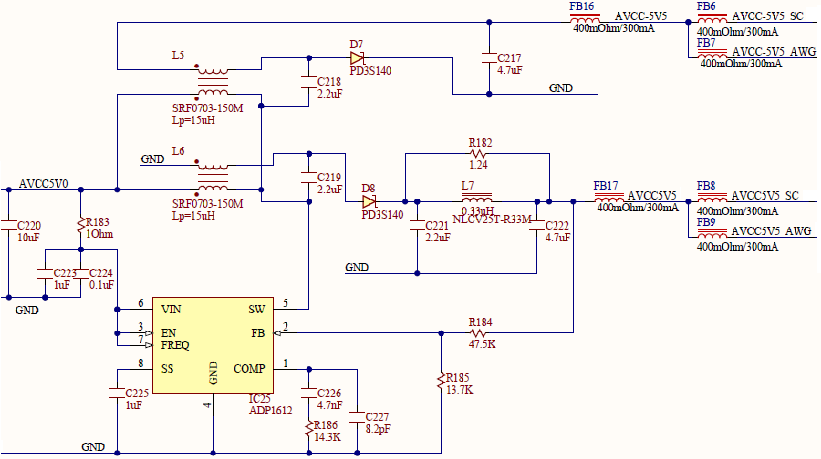 figure_30._5.5v_internal_analog_supplies
figure_30._5.5v_internal_analog_supplies
The output current in a Sepic is discontinuous which results in a higher output ripple. To lower this ripple an additional output filter is added to the positive rail.
For more information see application note: AN-1106: An Improved Topology for Creating Split Rails from a Single Input Voltage.
Setting the Output Voltage:
$$\frac{{{R_{184}}}}{{{R_{185}}}} = \;\frac{{{V_{out}} - {V_{ref}}}}{{{V_{ref}}}}\label{70}\tag{70}$$
Choosing ${R_{185}} = 13.7k\Omega$:
$$R_{184}= \frac{5.5V-1.235V}{1.235V} \cdot 13.7k \Omega = 47.31k \Omega\label{71}\tag{71}$$
Closest standard value is ${R_{184}} = 47.5k\Omega$
6.5.2. Digital Supplies
The 1V digital supply (Fig. 31) is implemented with the ADP2120-1. It has a fixed 1V output voltage option and a ±1.5% output accuracy which makes it suitable for the FPGA internal power supply. It also features:
- 1.25A continuous output current
- 145 mΩ and 70 mΩ integrated MOSFETs
- Input voltage range from 2.3 V to 5.5 V; output voltage from 0.6 V to VIN
- 1.2 MHz fixed switching frequency; Selectable PWM or PFM mode operation
- Current mode architecture
- Integrated soft start; Internal compensation
- UVLO, OVP, OCP, and thermal shutdown
- 10-lead, 3 mm × 3 mm LFCSP_WD package
The 3.3V digital supply (Fig. 32) uses ADP2503-3.3 600mA, 2.5MHz Buck-Boost DC-to-DC Converter:
- Seamless transition between modes
- 38 μA typical quiescent current
- 2.5 MHz operation enables 1.5 μH inductor
- Input voltage: 2.3 V to 5.5 V;
- Fixed output voltage: 3.3 V
- Forced fixed frequency
- Internal compensation
- Soft start
- Enable/shutdown logic input
- Overtemperature protection
- Short-circuit protection
- Reverse current capability
- Undervoltage lockout protection
- Small 10-lead 3 mm × 3 mm package, 1 mm height profile
- Compact PCB footprint
The main requirement for the 3.3V digital supply is the reverse current capability. When a user pin is overdriven the protection diode opens and back powers circuitry connected to this supply. If the back powered energy is higher than the used energy the regulator delivers it to its input, preventing the 3.3V from rising.
The 1.8V digital power supply (Fig. 33) is implemented with ADP2138-1.8 Fixed Output Voltage, 800mA, 3MHz, Step-Down DC-to-DC converter. This ensures a very small solution size due to the 3MHz switching frequency and the 1mm × 1.5 mm WLCSP package.
The ADP2138 also features:
- Input voltage: 2.3 V to 5.5 V
- Peak efficiency: 95%
- Typical quiescent current: 24 μA
- Fast load and line transient response
- 100% duty cycle low dropout mode
- Internal synchronous rectifier, compensation, and soft start
- Current overload and thermal shutdown protections
- Ultra-low shutdown current: 0.2 μA (typical)
- Forced PWM and automatic PWM/PSM modes
6.6. Temperature Measurement
The Analog Discovery 2 uses the AD7415 Digital Output Temperature Sensor (Fig. 34). AD7415 main features are:
- 10-bit temperature-to-digital converter
- Temperature range: −40°C to +125°C
- Typical accuracy of ±0.5°C at +40°C
- SMBus/I2C®-compatible serial interface
- Temperature conversion time: 29μs (typical)
- Space-saving 5-lead SOT-23 package
- Pin-selectable addressing via AS pin
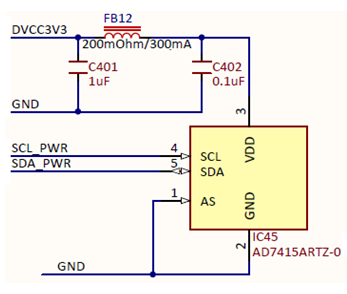 figure_34._temperature_measurement
figure_34._temperature_measurement
7. USB Controller
The USB interface performs two tasks:
- Programming the FPGA: There is no non-volatile FPGA configuration memory on the Analog Discovery. The WaveForms software identifies the connected device and downloads an appropriate .bit file at power-up, via a Digilent USB-JTAG interface. Adept run-time is used for low level protocols.
- Data exchange: All instrument configuration data, acquired data and status information is handled via a Digilent synchronous parallel bus and USB interface. Speed up to 20MB/sec. is reached, depending on USB port type and load as well as PC performance.
8. FPGA
The core of the Analog Discovery 2 is the Xilinx Spartan-6 FPGA circuit XC6SLX16-1L. The configured logic performs:
- Clock management (12 MHz and 60 MHz for USB communication, 100 MHz for data sampling)
- Acquisition control and Data Storage (Scope and Logic Analyzer)
- Analog Signal synthesis (look-up tables, AM/FM modulation for AWG)
- Digital signal synthesis (for pattern generator)
- Trigger system (trigger detection and distribution for all instruments )
- Power supplies control and instruments enabling
- Power and temperature monitoring
- Calibration memory control
- Communication with the PC (settings, status data)
Block and Distributed RAM of the FPGA are used for signal synthesis and acquisition. Multiple configuration files are available through the WaveForms software to allocate the RAM resources according to the application.
Detail of the trigger system is shown in Fig. 35. Each instrument generates a trigger signal when a trigger condition is met. Each trigger signal (including external triggers) can trigger any instrument and drive the external trigger outputs. This way, all the instruments can synchronize to each other.
//{{anchor:figure_35:Figure 35. FPGA configuration trigger block diagram.}}//
9. Features and Performances
This chapter shows the features and performances as described in the Analog Discovery 2 Datasheet. Footnotes add detailed information and annotate the HW description in this Manual.
9.1. Analog Inputs (Scope)
- Channels: 2
- Channel type: differential8)
- Resolution: 14-bit
- Absolute Resolution(scale ≤0.5V/div9)): 0.32mV
- Absolute Resolution(scale≥1V/div10)): 3.58mV
- Accuracy (scale≤0.5V/div, VinCM = 0V): ±10mV±0.5%
- Accuracy (scale≥1V/div, VinCM = 0V): ±100mV±0.5%
- CMMR (typical): ±0.5%
- Sample rate (real time): 100 MSPS
- Input impedance: 1MΩ||24pF
- Scope scales: 500uV to 5V/div11)
- Analog bandwidth with Discovery BNC adapter12): 30 MHz+ @ 3dB, 10 MHz @ 0.5dB, 5 MHz @ 0.1dB
- Analog bandwidth with Wire Kit13): 9 MHz @ 3dB, 2.9 MHz @ 0.5dB, 0.8 MHz @ 0.1dB
- Input range: ±25V (±50V diff14))
- Input protected to: ±50V;
- Buffer size/channel: Up to 16k samples15)
- Triggering: edge, pulse, transition, hysteresis, etc.16)
- Cross-triggering with Logic Analyzer, Waveform Generator, Pattern Generator or external trigg17).
- Sampling modes: average, decimate, min/max18)
- Mixed signal visualization (analog and digital signals share same view pane)19)
- Real-time views: FFTs, XY plots, Histograms and other20)
- Multiple math channels with complex functions11.
- Cursors with advanced data measurements21)
- Captured data files can be exported in standard formats22)
- Scope configurations can be saved, exported and imported23)
9.2. Analog Outputs (Arbitrary Waveform Generator)
- Channels: 2
- Channel type: single ended
- Resolution: 14-bit
- Absolute Resolution(amplitude ≤1V): 166μV
- Absolute Resolution(amplitude >1V): 665μV
- Accuracy - typical (|Vout| ≤ 1V): ±10mV ± 0.5%
- Accuracy - typical (|Vout| > 1V): ±25mV ± 0.5%
- Sample rate (real time): 100 MSPS24)
- AC amplitude (max): ±5 V25)
- DC Offset (max): ±5 V26)
- Analog bandwidth with Discovery BNC adapter27): 12 MHz @ 3dB, 4 MHz @ 0.5dB, 1 MHz @ 0.1dB
- Analog bandwidth with Wire Kit28): 9 MHz @ 3dB, 2.9 MHz @ 0.5dB, 0.8 MHz @ 0.1dB
- Slew rate (10V step): 400V/μs
- Buffer size/channel: up to 16k samples29)
- Standard waveforms: sine, triangle, sawtooth, etc.
- Advanced waveforms: Sweeps, AM, FM30).
- User-defined arbitrary waveforms: defined within WaveForms software user interface or using standard tools (e.g. Excel)31).
9.3. Logic Analyzer
- Channels: 16 (shared)32)
- Sample rate (real time): 100 MSPS
- Buffer size/channel: up to 16K samples33)
- Input logic: LVCMOS (1.8V/3.3V, 5V tolerant)
- Multiple trigger options including pin change, bus pattern, etc34).
- Cross-triggering between Analog input channels, Logic Analyzer, Pattern Generator or external trigger35).
- Interpreter for SPI, I2C, UART, Parallel bus36).
- Data file import/export using standard formats37).
9.4. Digital Pattern Generator
- Channels: 16 (shared)38)
- Sample rate (real time): 100 MSPS
- Algorithmic pattern generator (no buffers used)39)
- Custom pattern buffer/ch.: up to 16Ksamples40)
- Output logic standard: LVCMOS (3.3V, 12mA)
- Data file import/export using standard formats41)
- Customized visualization for signals and busses42).
9.5. Digital I/O
- Channels: 16 (shared)43).
- Input logic: LVCMOS (1.8V/3.3V, 5V tolerant)
- Output logic standard: LVCMOS (3.3V, 12mA)
- Virtual I/O devices (buttons, switches & displays)44).
- Customized visualization options available45).
9.6. Power Supplies
9.7. Network Analyzer*³
- Shared instruments: Scope, AWG
- Frequency sweep range: 1Hz to 10MHz
- Frequency steps: 5 … 100051).
- Settable input amplitude and offset
- Analog input records response at each frequency52).
- Available diagrams: Bode, Nichols, or Nyquist53).
9.8. Voltmeters°
- Channels (shared with scope): 2
- Channel type: differential
- Measurements: DC, AC, True RMS54).
- Resolution: 14-bit
- Accuracy (scale ≤0.5V/div): ±5mV
- Accuracy (scale ≥1V/div): ±50mV
- Input impedance: 1MΩ || 24pF
- Input range: ±25V (±50V diff)
- Input protected to: ±50V
9.9. Spectrum Analyzer°°
- Channels (shared with scope): 2
- Power spectrum algorithms: FFT, CZT55).
- Frequency range modes: center/span, start/stop56).
- Frequency scales: linear, logarithmic57).
- Vertical axis options: voltage-peak, voltage-RMS, dBV and dBu58).
- Windowing: options: rectangular, triangular, hamming, Cosine, and many others59).
- Cursors and automatic measurements: noise floor, SFDR, SNR, THD and many others60).
- Data file import/export using standard formats61).
9.10. Other features
- USB power option; all needed cables included.
- External supply option: 5V, 2.5A (not included)
- High-speed USB2 interface for fast data transfer
- Waveform Generator output played on stereo audio jack
- Trigger in/trigger out allows multiple instruments to be linked62).
- Cross triggering between instruments63).
- Help screens, including contextual help64).
- Instruments and workspaces can be individually configured; configurations can be exported65).

